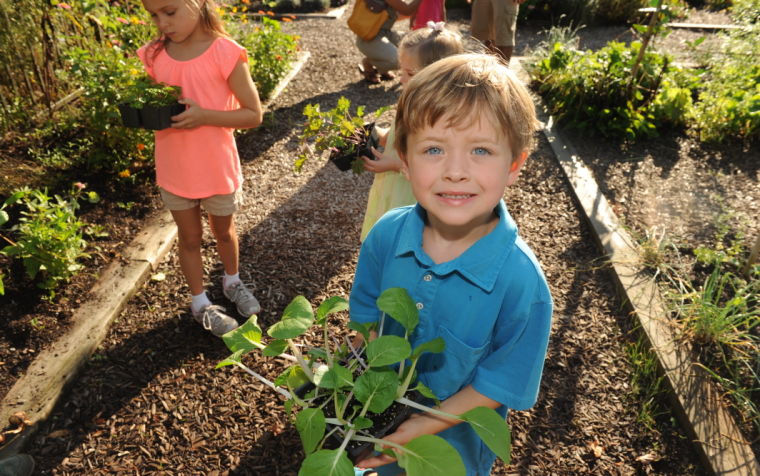Gardening: Growing the Next Generation of Gardeners
by Lynn Kirk, Public Relations Writer, Lewis Ginter Botanical Garden, reprinted with permission from the Richmond Times-Dispatch

Cale McCormick, along with cousins Logan (left) and Marin Snyder, prepares to plant bok choy. Photo by Scott Elmquist
“I’m a gardener,” 6-year-old Morgan Veneziano boasted with a big-girl smile. Morgan earned the prestigious title by helping in her family’s Louisa County vegetable garden from the time she learned to walk. In recent years, she earned something else: her very own garden plot. “I can plant things like carrots and cucumbers,” she explained. “Last year, the cucumbers grew really tall and big, and I ate them!”
Kristin Mullen, early childhood program developer at Lewis Ginter Botanical Garden, noted that hands-on gardening experiences like Morgan’s are priceless for children of all ages. Mullen encourages adults, caretakers and educators to welcome children into the garden with them. Backyard, urban and schoolyard gardens not only provide opportunities for fresh air and exercise, but also double as outdoor classrooms.
Now is a good time to plan a garden as a family or class, while waiting for the final frost (around April 15). Read related storybooks, look at age-appropriate garden guides or plant seeds indoors and watch them grow into seedlings for future transplanting. As the weather warms and outdoor gardening chores begin, provide child-sized tools, keep safety first and don’t insist on perfection.
Mullen suggests remaining flexible, ready to respond to whatever interests the child. A morning of weeding may become a time of watching caterpillars if the youngster has his or her way. “Just follow their lead and think of yourself as a learner, too,” Mullen said. “Gardening with children gives them a sense of their place in the world. It plants a seed that teaches them to care about plants and nature, and it might even open the door to future careers.”
Themed gardens can add to the fun and enhance the learning experience. For preschoolers, a rainbow garden filled with bright, multicolored flowers offers living examples of shapes and colors, while an herb garden provides opportunities to experience different smells, tastes and textures.
Peter Rabbit gardens planted with lettuce, carrots and other vegetables encourage nutritious eating. For middle-schoolers, sun and shade gardens demonstrate the sun’s influence on plant life and seasons, while butterfly gardens with host and nectar plants demonstrate life cycles and the interdependence of flora and fauna.

Morgan Veneziano takes great pride in having her own garden, where she grows all kinds of vegetables.
Older children enjoy the challenge of plant and wildlife identification, container gardening that recycles found objects — retired boots, old tires and book bags — and helping prepare meals with their harvests. Teens who help in community gardens and donate excess produce to hunger relief organizations experience firsthand the joy of volunteerism and stewardship.
“If the adult is excited, he or she will draw the children in. Attitude is everything,” Mullen said. However, she cautions adults not to take the role of teacher too seriously. “You’re just the facilitator in the learning process.” Children cannot employ problem-solving skills when adults are too quick to provide all the answers, and though some successes are important for self-satisfaction, gardening mistakes teach valuable lessons about cause and effect.
Morgan is more interested in her own garden and what it offers her. “I play in it, dig in it and sit in it,” she said. “And this year, Mama gave me a camera, so I’m even going to take pictures of it.”
Editor’s Note: This article first published in the Richmond Times-Dispatch, in March 2014.